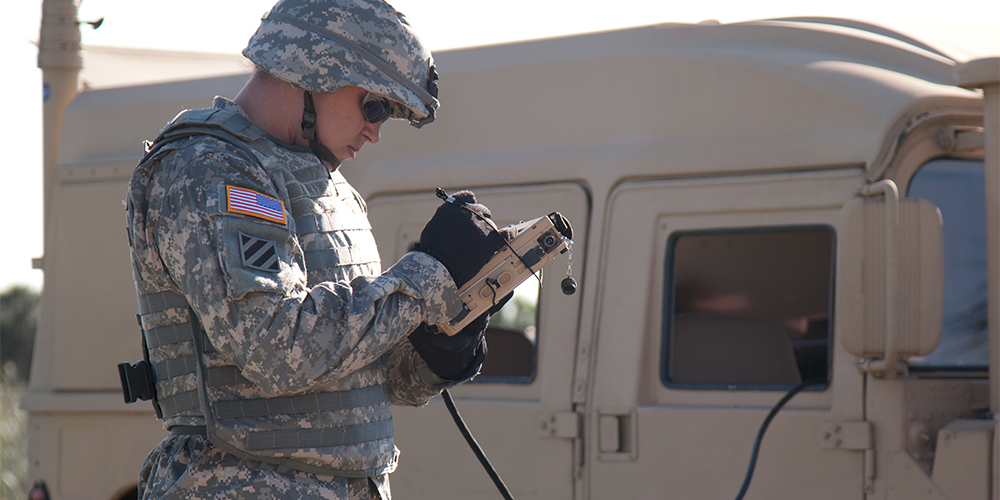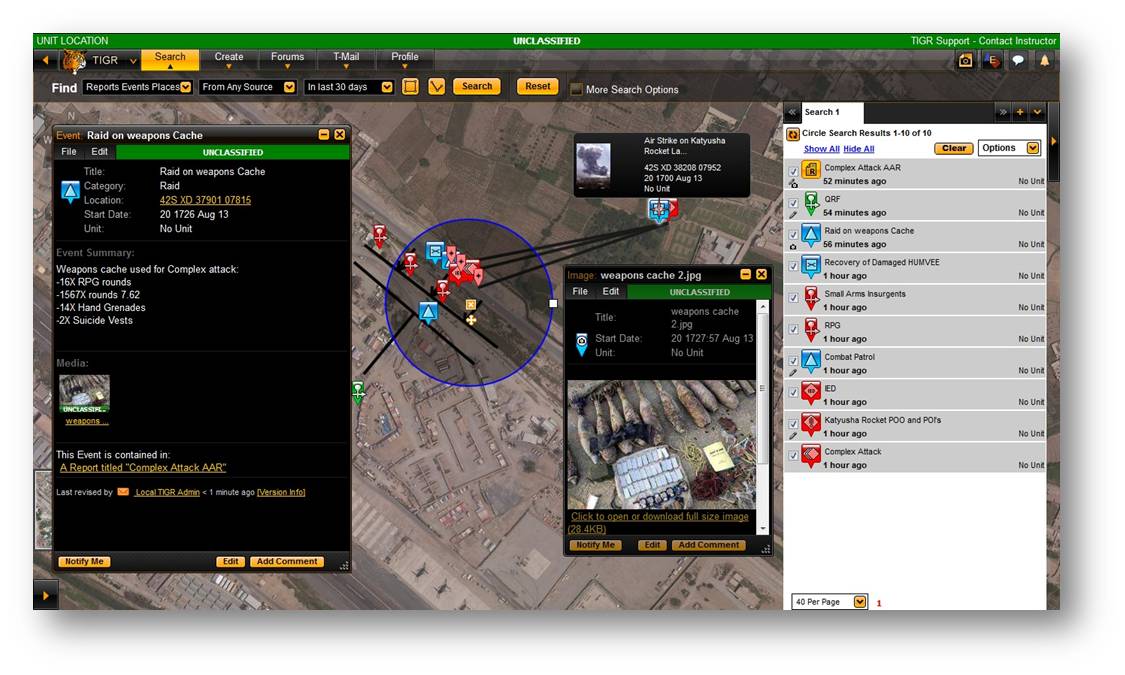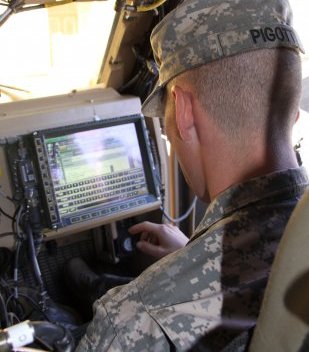
By Nancy Jones-Bonbrest, PEO C3T
ABERDEEN PROVING GROUND, Md. (Dec. 3, 2013) — Just as many Americans continue to unplug and go mobile, so does Army mission command.
As a vital link between dismounted Soldiers and their higher headquarters, tactical vehicles are evolving into mobile mission command centers – strapped with the latest in situational awareness and messaging technology.
This fiscal year the Army plans to field Joint Battle Command-Platform, or JBC-P, the next-generation system providing mounted mission command, friendly force tracking and situational awareness capabilities. JBC-P will also serve as the first version of the Mounted Computing Environment, known as the MCE, one of six computing environments that make up the Army’s Common Operating Environment, or COE, a new set of standards that enable the rapid development of secure and interoperable applications.
JBC-P provides the foundation for the MCE, allowing Soldiers to access new applications, as well as tools they rely on today such as Tactical Ground Reporting, or TIGR. This user-friendly JBC-P framework will also operate seamlessly with the smartphone-like Nett Warrior devices that deliver timely blue force tracking and situational awareness information down to dismounted Soldiers.

Joint Battle Command-Platform provides the foundation for the Mounted Computing Environment, allowing Soldiers to access new applications, as well as tools they rely on today such as Tactical Ground Reporting, pictured above. By incorporating TIGR into JBC-P, Soldiers out on patrol can access a searchable database of unit activities that uses a Google Earth-like interface, pictures and text. (Photo Credit: Courtesy of General Dynamics)
“If you compare the mobile, handheld computing environment to an iPhone and compare the stationary command post computing environment to a desktop computer, MCE – with JBC-P being the core capability – is the iPad,” said Lt. Col. Michael Olmstead, product manager for JBC-P. “You might not necessarily need the same app for the handheld that you need for the command post, but just like the commercial model, they would be compatible and interoperable.”
By incorporating TIGR into JBC-P, Soldiers out on patrol can access a searchable database of unit activities that uses a Google Earth-like interface, pictures and text. TIGR can disseminate tactical information across multiple Army echelons and systems, and allows units to track people such as local police chiefs, religious leaders or other key figures for counterinsurgency and stability operations.
“The ability to upload everything that was significant after a patrol, and to know that anybody on that network can see what I uploaded, is a great asset,” said Staff Sgt. Scott Harrison, with the task analysis branch of the Maneuver Center of Excellence Directorate of Training and Doctrine.
Harrison, who used a previous version of TIGR while deployed to Iraq, recently evaluated the next generation of TIGR at Fort Benning, Ga., during a U.S. Army Training and Doctrine Command Capability Manager, Brigade Combat Team Mission Command, or BCT MC, user jury.
“I planned patrols in and out of Fallujah almost every day and TIGR was my main asset,” Harrison said. “I would pull up the historical data for what happened in my area, and it would allow me to plan my routes. To have situational awareness of what had happened in the area historically was invaluable.”

A Soldier uses Joint Battle Command-Platform at a Network Integration Evaluation event. Feedback from Army user juries and NIEs helped shape the new situational awareness capability JBC-P. (Photo Credit: Claire Heininger, PEO C3T)
JBC-P is the Army’s latest incarnation of the widely fielded mounted friendly force tracking system known as Force XXI Battle Command Brigade-and-Below/Blue Force Tracking, or FBCB2/BFT. Displaying blue and red icons over a digital map, FBCB2/BFT has provided lifesaving situational awareness information to Soldiers in Iraq and Afghanistan.
Today, that blue force tracking information is being delivered down to dismounted Soldiers through the Army’s handheld mission command system known as Nett Warrior. Composed of an Android handheld device connected to a tactical radio, Nett Warrior allows dismounted leaders to see their own location, the locations of their fellow Soldiers and the locations of known enemies on a moving map. Recent work between the JBC-P and Nett Warrior project offices has improved the interoperability of these two systems, filling a critical gap in mission command between mounted and dismounted Soldiers.
Project Manager, PM JBC-P, assigned to the Program Executive Office Command, Control and Communications-Tactical, is also developing a pilot that would enable compatibility between new Android-based capabilities certified by the Army and the JBC-P baseline.
“JBC-P is the core of the MCE, which is a game-changer for mission command on the move,” Olmstead said. “MCE allows us to streamline product development of emerging technology while ensuring capabilities are compatible across the Army.”
The Army’s COE strategy embraces a commercially-based set of standards that enable secure and interoperable applications to be rapidly developed.
“Under the MCE, developers will provide just those unique components or ‘apps’ that take advantage of the common software provided by the MCE framework instead of creating a whole separate program with its own operating system and services,” said John Gillette, PM JBC-P team lead for MCE. “Our initiative to leverage the Android environment will utilize an open standard that everyone knows and understands. That’s the real power of it.”
The overall goal of the MCE is to bring together the diverse mission command systems that are on the platforms today, reducing redundant software services and shrinking the command and control hardware footprint. To do this, PM JBC-P is capitalizing on the current FBCB2/BFT hardware that is integrated on more than 120,000 platforms.
As JBC-P accepts the migration of more capabilities through the MCE, the need for increased performance is evident. Invoking a Headquarters, Department of the Army directed requirement, PM JBC-P issued a contract for the development of common hardware for mounted platforms, known as the Mounted Family of Computer Systems. This new capability will bring interoperability through standardized tactical computers that are scalable and tailorable to the mission and vehicle. It also reduces size, weight and power demands, a key element of COE and a crucial enabler for MCE.
In celebration of the 25th anniversary of the Army Acquisition Corps (AAC), Access is publishing articles that highlight milestones throughout the history of the AAC. Each article marks a moment in acquisition excellence.
This article was published on Army.mil, December 3, 2013.







